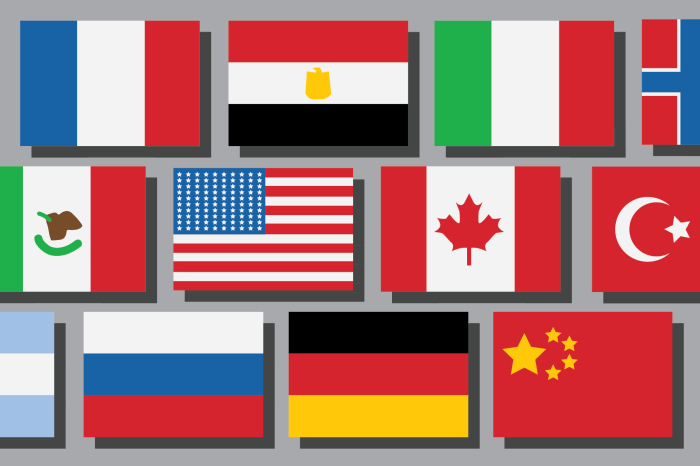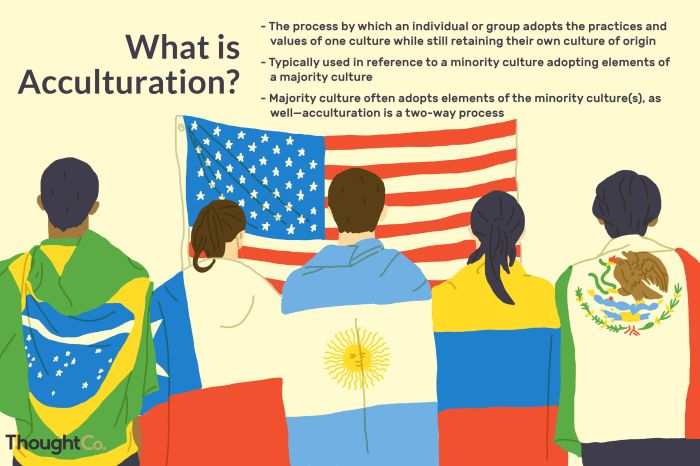The process of adapting borrowed cultural traits is a multifaceted and dynamic phenomenon that shapes societies and cultures around the globe. As individuals and communities encounter new cultural influences, they embark on a journey of adaptation, assimilation, and transformation, leading to the creation of unique and vibrant cultural landscapes.
This process involves a complex interplay of factors, including acculturation, cultural diffusion, syncretism, resistance, and exchange. Understanding these mechanisms provides insights into the ways in which cultures evolve and adapt in an increasingly interconnected world.
1. Acculturation and Assimilation

Acculturation refers to the process of cultural adaptation and change that occurs when individuals or groups come into contact with a new culture. Assimilation, on the other hand, is the process of adopting the cultural traits and behaviors of a new culture while abandoning one’s own.
Factors that influence the rate and extent of acculturation and assimilation include:
- The degree of contact between the two cultures
- The power differential between the two cultures
- The motivation of individuals to acculturate or assimilate
- The availability of support from the host culture
2. Cultural Diffusion

Cultural diffusion is the spread of cultural traits from one society to another. It can occur through various mechanisms, such as trade, travel, and migration.
Examples of cultural diffusion include:
- The spread of Christianity from Europe to Africa and Asia
- The adoption of Western clothing styles in many parts of the world
- The globalization of fast food restaurants
3. Cultural Syncretism: The Process Of Adapting Borrowed Cultural Traits
Cultural syncretism is the process of combining elements from two or more cultures to create a new cultural form. It can occur when two cultures come into contact and exchange ideas, beliefs, and practices.
Examples of cultural syncretism include:
- The fusion of African and European musical traditions in the Americas to create new genres such as jazz and blues
- The blending of Chinese and Japanese cuisine to create new dishes such as sushi and ramen
- The emergence of new religious movements that combine elements from different faiths
4. Cultural Resistance

Cultural resistance refers to the process of rejecting or resisting the adoption of foreign cultural traits. It can occur when individuals or groups feel threatened by the perceived loss of their own cultural identity.
Examples of cultural resistance include:
- The rejection of Western cultural values in some traditional societies
- The revival of indigenous languages and cultural practices in many parts of the world
- The formation of nationalist movements that seek to preserve a distinct cultural identity
5. Cultural Exchange
Cultural exchange refers to the sharing and dissemination of cultural traits between different societies. It can occur through various mechanisms, such as trade, travel, and education.
Cultural exchange can facilitate the adaptation of borrowed cultural traits by:
- Providing opportunities for individuals to learn about and experience new cultures
- Creating a sense of respect and understanding for different cultural perspectives
- Promoting the development of new cultural forms that reflect the融合of different traditions
FAQ Compilation
What is the difference between acculturation and assimilation?
Acculturation refers to the process of adopting certain cultural traits of another culture while maintaining one’s own cultural identity. Assimilation, on the other hand, involves the complete adoption of another culture, often accompanied by the loss of one’s original cultural identity.
How does cultural diffusion contribute to the spread of borrowed cultural traits?
Cultural diffusion is the process by which cultural traits are transmitted from one society to another through contact and interaction. It can occur through trade, travel, migration, or other forms of cultural exchange.
What is cultural syncretism and how does it impact the adaptation of borrowed cultural traits?
Cultural syncretism refers to the blending of elements from different cultures to create new cultural forms. It can result in the creation of unique and distinctive cultural practices and beliefs.
How does cultural resistance influence the adoption of borrowed cultural traits?
Cultural resistance occurs when individuals or groups reject or modify borrowed cultural traits in order to preserve their own cultural identity. It can lead to the selective adoption or rejection of certain cultural influences.
What is the role of cultural exchange in the process of adapting borrowed cultural traits?
Cultural exchange involves the sharing and dissemination of cultural traits between different societies. It can facilitate the adoption and adaptation of borrowed cultural traits, while also promoting cross-cultural understanding and cooperation.